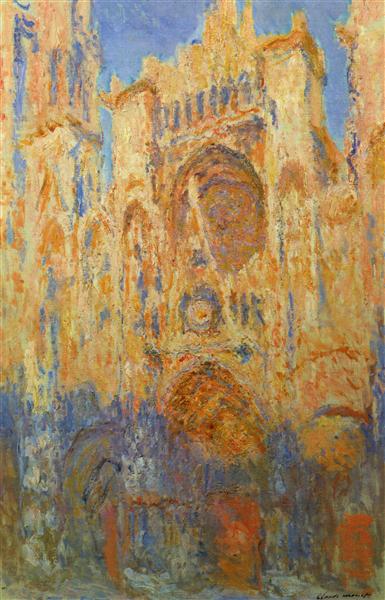Description
The work "Ruan Cathedral" (Cathedral Rouen) of 1893, is a notable example of Claude Monet's innovative approach to light and atmosphere. Monet, a pioneer of the impressionist movement, dedicated a significant part of his work to represent the cathedral of Ruan, a building that considered an inexhaustible source of inspiration, and whose majestic facade becomes a focal point where the subtleties of light and color They intertwine in a visual dance.
When observing the painting, it is evident that Monet moves away from a literal representation and seeks to capture the effect of light on the architectural surface. The cathedral, undisputed protagonist, is barely outlined in detail, which makes the viewer focus on the nuances of light and shadow that fall on their stones. This simplification technique is characteristic of impressionist language, where the perception of the moment on the precision of the object is prioritized. Through its loose brushstroke and its carefully chosen color palette, Monet captures the essence of the place at a specific time, impregnated with the surrounding atmosphere.
The color game is extremely interesting. The cathedral is bathed in different shades of blue, violet and lavender, accentuated by touches of gold and orange where sunlight filters. This palette not only evokes the feeling of an enlightened day, but also invites introspection, creating a mood that harmonizes with the spirituality of the religious building. Monet often achieved this effect by applying oil paint layers, which allowed him to work the color with a degree of vibration that is fascinating.
The work does not include visible characters, but the treatment of surrounding space suggests an intimate relationship between the cathedral and the observer. The absence of human figures reinforces the greatness of architecture and allows the viewer to meditate on the scale and emotional impact of the cathedral. In this sense, Monet not only presents a monument, but makes it a symbol of human experience in the face of the immensity of nature and the work of man.
In addition to its virtuous color and light treatment, this painting is part of a broader series in which Monet worked while being in Ruan. Throughout different hours of the day and in various climatic conditions, he explored variations on the same subject, capturing the constant change in perception. This dedication to a particular subject is a distinctive characteristic of Monet, which found in its immediate environment a laboratory for artistic exploration.
The "Ruan Cathedral" of 1893 not only represents a masterpiece of impressionism, but also a manifestation of Monet's committed dialogue with time and space. Through this and other works, Monet managed to establish a new visual language that questions the reality of representation and invites us to appreciate the ephemeral beauty of the world around us. With its unique ability to translate light into color, Monet left a legacy that continues to influence generations of artists and critics, reaffirming its position as one of the greatest masters of painting.
KUADROS ©, a famous paint on your wall.
Hand-made oil painting reproductions, with the quality of professional artists and the distinctive seal of KUADROS ©.
Reproduction service paintings With a guarantee of satisfaction. If you are not completely satisfied with the replica of your painting, we refund your money 100%.

